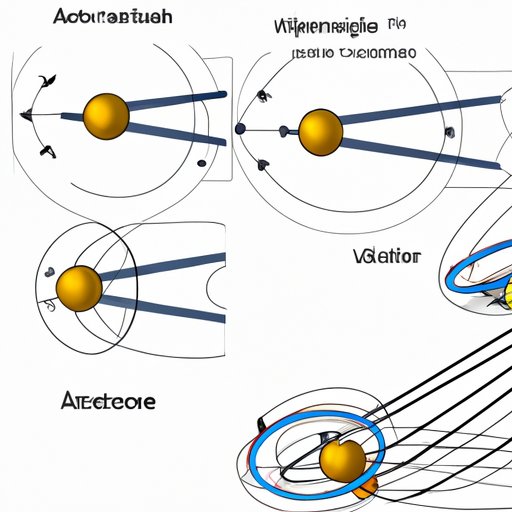
Introduction
Angular velocity is a fundamental concept in the field of physics that describes the rate at which an object rotates around a given axis. It is an essential tool in understanding and analyzing rotational motion in many fields, including engineering, astronomy, and sports. In this article, we will explore how to find angular velocity, its properties, and its applications in different fields.
Angular Motion and Principles Governing it
Angular motion is the motion of an object rotating around an axis. This is different from linear motion, which is the motion of an object moving along a straight line.
A few properties of angular motion include:
- Angular displacement: the angle covered by an object while rotating around an axis.
- Angular velocity: the rate of change of angular displacement.
- Angular acceleration: the rate of change of angular velocity.
- Angular momentum: the tendency of a rotating object to continue to rotate.
The key concept we will focus on in this article is angular velocity.
Calculating Angular Velocity
Angular velocity is the measure of the speed of rotation of an object around an axis.
The formula to calculate angular velocity is:
ω = Δθ/Δt
Where ω is the angular velocity, Δθ is the angular displacement, and Δt is the time taken to cover that displacement.
Angular velocity is measured in radians per second (rad/s).
The formula above works well for situations where the angular displacement is uniform, meaning that the rotation rate is constant throughout the rotation. However, in situations where the rotation rate is not uniform, the formula becomes more complicated. In these cases, you may need calculus to find the instantaneous angular velocity at a specific point in time.
Differences Between Linear and Angular Velocity
Linear velocity describes the rate of change of an object’s position, while angular velocity describes the rate of change of an object’s orientation. Linear velocity is measured in meters per second (m/s), while angular velocity is measured in radians per second (rad/s).
Another critical concept to keep in mind when working with angular velocity is rotational inertia. It is a property of an object that depends on its shape and mass distribution. Moments of inertia correspond to the rotational inertia in different directions. It is challenging to calculate rotational inertia in complex systems, but it’s essential to understand how it influences angular velocity.
Practical Applications of Angular Velocity
Angular velocity is used in many fields, including physics, engineering, and sports. Here are some examples:
- In physics, angular velocity is used to calculate the rotational speed of planets and stars, which helps scientists understand celestial mechanics.
- In engineering, angular velocity is used to calculate the stresses and strains of rotating parts in machines and devices.
- In sports, angular velocity is essential in analyzing the movements and performances of athletes. For example, in gymnastics, angular velocity is used to calculate the rotational speed of flips, twists, and turns.
Understanding how to find angular velocity is crucial to understanding and analyzing the rotational motion in these fields.
Finding Angular Velocity in Different Scenarios
To find angular velocity in different situations, we need to identify the angular displacement, the time taken to cover that displacement, and the direction of rotation. Here are some examples:
- Rotating Objects: Suppose a wheel makes 5 revolutions in 10 seconds. The angular displacement would be 2π × 5. Suppose we want to find the angular velocity in radians per second, then we can use the formula above.
- Pendulums: The angular velocity of a pendulum is calculated by dividing the linear velocity by the distance from the center of rotation (in this case, the pivot point) to the mass’s center.
- Wheels: Suppose you have a motorcycle wheel that is 60 centimeters in diameter, and it is rotating at 100 revolutions per minute. First, find the distance the wheel travels in one revolution, which would be π × 60 centimeters. Then, find the distance it travels in one minute by multiplying by the number of revolutions per minute. Finally, convert the distance to meters and calculate the angular velocity by dividing the distance by the time.
Math behind Calculating Angular Velocity
Investigating the math behind calculating angular velocity can help you develop a deeper understanding of the concept.
If an object is rotating in one dimension, then the angular displacement is given by:
Δθ = ω × Δt
If the rotation is happening in two dimensions, then we can calculate the angular displacement using:
Δθ = arc tan(Δy/Δx)
The angular velocity is then given by ω = Δθ/Δt.
If the rotation is happening in three dimensions, we can use vectors to calculate the angular velocity. The formula for angular velocity in this case is:
ω = r × v
Where r is the position vector and v is the velocity vector.
Importance of Understanding Angular Velocity
Understanding how to find angular velocity is essential to many fields, including physics, engineering, and sports. It’s crucial to understanding rotational motion, which is a fundamental concept in these fields. By mastering the concept of angular velocity, you can understand how various systems that rotate around a fixed axis work. You’ll be able to calculate and analyze the motion of objects and systems that involve rotational motion.
Conclusion
In conclusion, angular velocity is a fundamental concept in the field of physics, engineering, and sports. It describes the rate at which an object rotates around a given axis. It’s essential to understand how to find angular velocity, including its properties, practical applications, and mathematical concepts. Understanding angular velocity and rotational motion can help you develop a more profound, more robust understanding of how various systems work. By mastering this concept, you’ll be better equipped to analyze the behavior of systems that involve rotational motion, which is essential in many fields.





